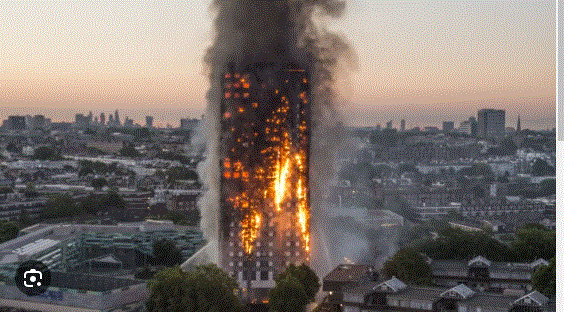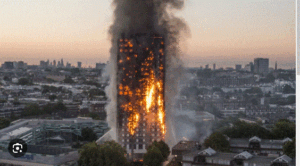
A high-rise fire broke out in the 24-storey Grenfell Tower block of flats in North Kensington
At 00:54 BST on June 14, 2017, a high-rise fire that lasted for 60 hours started at the 24-story Grenfell Tower
apartment complex in North Kensington, West London, England. More than 70 people were injured, 223 managed
to escape, and 70 people died at the spot and two more died later in the hospital. It was the worst home fire in the
UK since the Blitz of World War II and the deadliest structural fire in the country since the 1988 Piper Alpha oil-
platform tragedy.
An electrical malfunction in a fourth-floor refrigerator caused the fire.The spaces surrounding window apertures
after window installation were irregular since Grenfell was an existing building that was initially constructed in
concrete to various tolerances. In order to ensure air-tightness, contractors filled these gaps with flammable foam
insulation.
 The rainscreen cavity, which was lined with 150 mm thick (5.9-inch) flammable polyisocyanurate rigid board
The rainscreen cavity, which was lined with 150 mm thick (5.9-inch) flammable polyisocyanurate rigid board
insulation and covered in aluminium composite cladding panels that included a 2 mm (0.079-inch) highly
flammable polyethylene filler to join each panel face together, was accessed by the foam insulation surrounding the
window jambs.
As is typical in rainscreen cladding systems, a ventilated cavity between the insulation board and rear of the cladding
panel existed; however, cavity barriers to the line of each flat were found to be inadequately installed, or not suitable
for the intended configuration, and this exacerbated the rapid and uncontrolled spread of fire, both vertically and
horizontally, to the tower.
In an attempt to contain the fire and save lives, more than 250 London Fire Brigade firemen and 70 fire engines
from stations throughout Greater London were called in as part of the massive event. At least 20 ambulances
carrying over 100 London Ambulance Service staff responded, along with specialised paramedics from the
Ambulance Service’s Hazardous Area Response Team. The rescue operation also received assistance from London’s
Air Ambulance and the Metropolitan Police.
A public inquiry, several intricate police investigations, and coroner’s inquests are all being conducted into the fire.
The management of the building by the Kensington and Chelsea London Borough Council and Kensington and
Chelsea TMO (which was in charge of the borough’s council housing), the Fire Brigade’s and other government
agencies’ responses.
Deregulation policy, building inspections, proper budgeting, fire safety systems, the materials used, the companies
that installed, sold and manufactured the cladding, and communications, advice and decision-making errors by
office holders are just a few of the Following the fire, the council took direct responsibility of council housing from
the KCTMO, and the chief executive, deputy leader and leader of the council resigned.
An independent assessment of fire safety and building standards was commissioned by Parliament, and the results
were released in May 2018. Governments in the UK and other countries have looked into tower blocks with
comparable cladding. These buildings’ cladding is currently being replaced. The cladding crisis in the United
Kingdom has been a consequence of this.
In order to look into the reasons behind the fire and other connected matters, the Grenfell Tower Inquiry was
underway on September 14, 2017. The investigation’s initial report, which addressed the night’s events, was
published in October 2019. It confirmed that the building’s exterior didn’t meet codes, which was the main cause of
the fire’s spread, and that the fire department arrived too late in
On January 27, 2020, a second phase to look into the wider reasons got underway. After lengthy hearings, the
Inquiry Panel released its final findings on September 4, 2024. Police investigations will find potential cases after
publication, and the Crown Prosecution Service will determine whether to file criminal charges. It is anticipated that
cases won’t be submitted before the end of 2026 due to the volume and intricacy of the material, with trials starting
in 2027. 22 companies, including the cladding company Arconic, Whirlpool, and other government agencies, came to
Parliament commissioned an independent review of building regulations and fire safety,a civil settlement with the 900 fire victims in April 2023.
Read more news on https://sportupdates.co.uk/

Leave a Reply